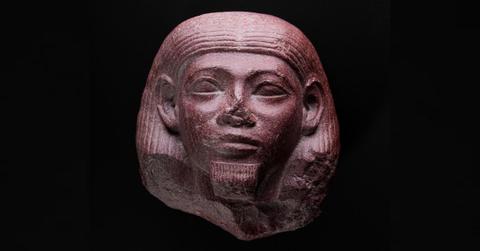How Did Rare Ancient Artifacts End Up in Scottish Potato Field 2,500 Miles Away From Egypt?

In 1952, a schoolboy in Scotland dug up this ancient Egyptian red sandstone statue head that has been called a "masterpiece of Egyptian sculpture."
Dec. 1 2023, Published 10:01 a.m. ET
In 1952, a Scottish schoolboy, tasked with digging up potatoes as a form of punishment, made an incredible discovery: a 4,000-year-old ancient Egyptian statue crafted from red sandstone.
What was initially mistaken for a spud is now recognized as a "masterpiece of Egyptian sculpture" from the mid-12th Dynasty, which dates the artifact to anywhere from 1922 B.C. to 1874 B.C., according to the National Museums Scotland (NMS).
The statue's head was the first of several ancient Egyptian treasures discovered at Melville House, a property located in northeast Scotland's Fife county. Originally constructed in 1697 for the Earl of Melville, the site was turned into a private boarding school in the 20th century.
Subsequent discoveries in the area include a bronze votive statuette of the god Apis, found in 1966 during a physical education class, and a bronze figurine a student located with a metal detector and unearthed in 1984, Knewz.com reported.
Intrigued, Royal Scottish Museum researchers visited Melville House and uncovered even more priceless artifacts, including part of a figurine depicting the Goddess Isis nursing her son Horus as well as a plaque featuring the "Eye of Horus." In total, 18 ancient Egyptian objects have been excavated from the property, Live Science reported.
For decades, scientists puzzled over how these artifacts ended up over 2,500 miles away from Egypt.
The prevailing theory now suggests that antique collectors in the 19th century collected these rare objects.
Alexander, Lord Balgonie, heir to Melville House, may have brought them back after a trip to Egypt in 1856, a time when Egyptian dealers commonly sold artifacts to tourists, according to NMS.
Never miss a story — sign up for the Front Page Detectives newsletter. Be on the scene the moment news breaks.
The artifacts might have been kept at the house before being moved to an outbuilding, where they were either forgotten or abandoned. When the outbuilding was demolished, the artifacts likely were buried with its debris.
Dr. Elizabeth Goring, NMS curator, noted, "Uncovering ancient Egyptian objects in Fife is clearly unexpected, and the subsequent research to establish the origins of the collection has provided a fascinating tale, albeit one with further mysteries which may never be solved."
The detailed findings will be published in an upcoming edition of the Proceedings of the Society of Antiquaries of Scotland.
Become a Front Page Detective
Sign up to receive breaking
Front Page Detectives
news and exclusive investigations.
